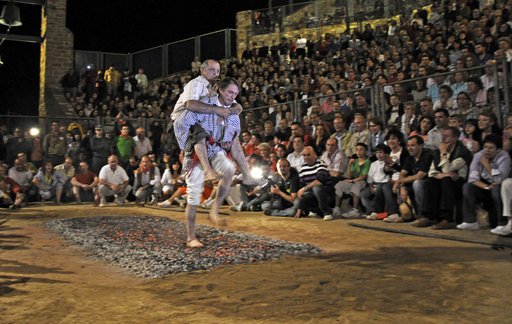
A study of a fire-walking ritual organised by RCC members Dimitris Xygalatas and Uffe Schjødt, and with the collaboration of two further RCC members, Joseph Bulbulia and Else-Marie Jegindø, recently made global headlines, featuring, among others, on the cover of the New York Times, in the International Herald Tribune, the Los Angeles Times, National Geographic, MSNBC, SNOB Magazine, and many others. The study has been reported by media around the world, from Ireland to Greece and from Russia to Ghana, bringing unprecedented attention to the RCC.
In our study, published in PNAS, we show that fire-walkers, family members, and friends share heart rates through an experience of a collective ritual. We wired up participants and spectators with heart monitors at an annual fire-walking ritual in San Pedro Manrique, Spain, to try and quantify the social connectedness that underlies community rituals. Using a sophisticated mathematical technique, we determined that family members or close friends were uniquely synchronized to changes in fire-walkers’ heart rates throughout the ceremony. The pattern of synchrony differed from non-related onlookers. The technique distinguishes the changes in heart rhythms and adrenaline surges one might experience as an ordinary onlooker, from onlookers who share emotional bonds with those who walk barefoot across hot coals. What is distinguished are the shared changes in cardiac activity signifying the individuals’ shared emotional experience. Firewalkers and their spectating loved ones, the researchers report, exhibit the same patterns throughout the ritual. Individuals who share emotional synchrony thus also share physiological synchrony. The investigation demonstrates a new method for quantifying the shared experience of collective rituals in human physiology.
The implications of our findings could perhaps be extended to various other forms of collective action, such as corporate team-building, affiliation in sports, public riots, warfare, and so on. Shared arousal might then be either one mechanism driving these collective actions, or a mechanism that emerges from the collective actions themselves.
This study was conducted by an interdisciplinary team of researchers from the RCC, the MINDLab, and the Center of Functionally Integrative Neuroscience, Aarhus University. The authors include RCC anthropologist, Dimitris Xygalatas, biomedical engineer Ivana Konvalinka, RCC researchers from the study of religion, Joseph Bulbulia, Uffe Schjødt, and Else-Marie Jegindø, two psychologists, Sebastian Wallot and Guy Van Orden, and Andreas Roepstorff, co-director of MINDLab.
See article in The New York Times: Hearts Beat as One in a Daring Ritual
See article in National Geographic: Your Heart Can Sync With a Loved One's
See article in Weekendavisen: Korporlig empati
See Dimitris’ interview for SNOB Magazine (if you speak Russian!)
For further information, e-mail Dimitris Xygalatas